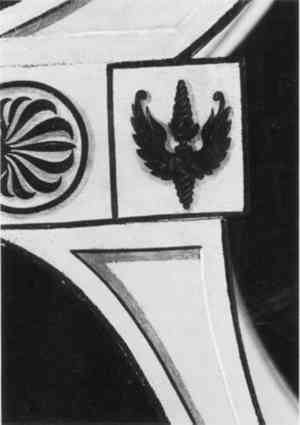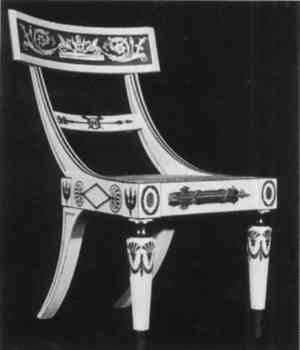THE CONSERVATION OF A PAINTED BALTIMORE SIDECHAIR (ca. 1815) ATTRIBUTED TO JOHN AND HUGH FINLAYPETER L. FODERA, KENNETH N. NEEDLEMAN, & JOHN L. VITAGLIANO
4 TREATMENTThe chair was cleaned in three basic phases, first removing the topcoat with xylene. The makeup of the topcoat and its removal were discussed in sections 2 and 3. The most recent and easily removed retouchings were also cleaned from the Cleaning allowed a reevaluation of the scope of the original design scheme of the klismos chair. Great delicacy and assuredness in the execution of the painted decoration and the abundant use of archaeologically inspired trompe l'oeil effects through careful attention to shadows rendered with transparent glazes are two of the striking features of the chair's design that could not have been fully appreciated for some decades (figs. 13, 14).
Our goal in the filling and inpainting stages of treatment was to strike a balance between allowing the history of wear on the piece to show and making the complexity and sophistication of the design understandable. Filling was accomplished with a traditional gesso made of whiting and rabbit skin glue. This procedure provided us with a white ground that functioned like the original white underlayer, giving light and clarity to the inpainted passages (fig. 15). Many of the voids to be filled contained residues of older, deeply entrenched oil paint that could not be safely removed. Areas of loss were isolated with a thin coating of Acryloid B-67 prior to filling.6 Excess fill material was removed with saliva and cotton swabs, and the surface was leveled with a scalpel. Inpainting was executed with water-color, followed by dry pigment in poly(vinyl acetate)-AYAB. Color saturation and surface gloss in the reconstructed areas were adjusted
Applying a finish coat to the chair was somewhat problematic. Test applications of different varnishes (e.g., Arkon, damar, B-67) accentuated the surface wear along the edges and interrupted the flow of the design elements. As the surface of the chair had the appearance of a thin, worn, original surface coating, it was decided that a thin coating of wax would provide some protection and at the same time help to integrate the restored areas. Comparison with the Kaufman card table assured us that their surface appearances would be similar. The chair was finished with a thin application of microcrystalline paste wax and buffed with cotton pads. While we feel we can safely say that we have come somewhat closer to understanding the chair's surviving original painted decoration, the question of original surface appearance lingers. It remains to be seen whether we will in the future be able to make a more accurate assessment of the degree of surface gloss the chair was meant to have. ACKNOWLEDGEMENTSThanks to Morry Heckscher, Peter Kenny, Mark Wypyski, and James Martin for their input during the project; to Gregory Weidman and Wendy Cooper for their exceptional scholarly contributions; to Martha Rowe for her research assistance; and to George and Linda Kaufman. The contribution of their efforts and insights not only ensured a successful outcome but also served to broaden our common understanding. |


